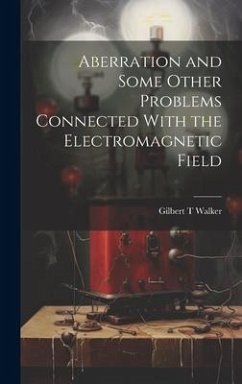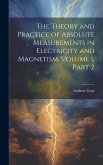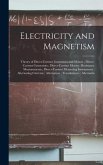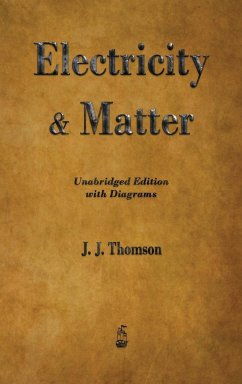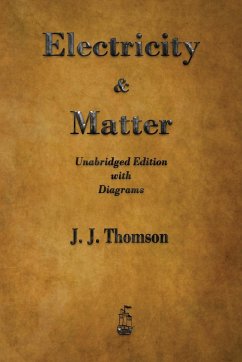Gilbert T. Walker
Aberration and Some Other Problems Connected With the Electromagnetic Field
Gilbert T. Walker
Aberration and Some Other Problems Connected With the Electromagnetic Field
- Gebundenes Buch
- Merkliste
- Auf die Merkliste
- Bewerten Bewerten
- Teilen
- Produkt teilen
- Produkterinnerung
- Produkterinnerung
In this book, Gilbert T Walker explores various problems related to the electromagnetic field, including the phenomenon of aberration in optics. He provides a detailed analysis of the mathematical equations that govern these problems, making it a valuable resource for students of physics and engineering. This work has been selected by scholars as being culturally important, and is part of the knowledge base of civilization as we know it. This work is in the "public domain in the United States of America, and possibly other nations. Within the United States, you may freely copy and distribute…mehr
Andere Kunden interessierten sich auch für
![Aberration and Some Other Problems Connected with the Electromagnetic Field Aberration and Some Other Problems Connected with the Electromagnetic Field]() Gilbert T. WalkerAberration and Some Other Problems Connected with the Electromagnetic Field49,99 €
Gilbert T. WalkerAberration and Some Other Problems Connected with the Electromagnetic Field49,99 €![The Theory and Practice of Absolute Measurements in Electricity and Magnetism, Volume 1, part 2 The Theory and Practice of Absolute Measurements in Electricity and Magnetism, Volume 1, part 2]() Andrew GrayThe Theory and Practice of Absolute Measurements in Electricity and Magnetism, Volume 1, part 237,99 €
Andrew GrayThe Theory and Practice of Absolute Measurements in Electricity and Magnetism, Volume 1, part 237,99 €![Electricity and Magnetism: Theory of Direct-Current Generators and Motors; Direct-Current Generators; Direct-Current Motors; Resistance Measureme Electricity and Magnetism: Theory of Direct-Current Generators and Motors; Direct-Current Generators; Direct-Current Motors; Resistance Measureme]() AnonymousElectricity and Magnetism: Theory of Direct-Current Generators and Motors; Direct-Current Generators; Direct-Current Motors; Resistance Measureme40,99 €
AnonymousElectricity and Magnetism: Theory of Direct-Current Generators and Motors; Direct-Current Generators; Direct-Current Motors; Resistance Measureme40,99 €![Electric Heating Electric Heating]() Edwin James HoustonElectric Heating31,99 €
Edwin James HoustonElectric Heating31,99 €![An Examination Of The Munsell Color System: I. Spectral And Total Reflection And The Munsell Scale Of Value An Examination Of The Munsell Color System: I. Spectral And Total Reflection And The Munsell Scale Of Value]() Irwin Gillespie PriestAn Examination Of The Munsell Color System: I. Spectral And Total Reflection And The Munsell Scale Of Value27,99 €
Irwin Gillespie PriestAn Examination Of The Munsell Color System: I. Spectral And Total Reflection And The Munsell Scale Of Value27,99 €![Electricity and Matter Electricity and Matter]() J. J. ThomsonElectricity and Matter17,99 €
J. J. ThomsonElectricity and Matter17,99 €![Electricity and Matter Electricity and Matter]() J. J. ThomsonElectricity and Matter11,99 €
J. J. ThomsonElectricity and Matter11,99 €-
-
-
In this book, Gilbert T Walker explores various problems related to the electromagnetic field, including the phenomenon of aberration in optics. He provides a detailed analysis of the mathematical equations that govern these problems, making it a valuable resource for students of physics and engineering. This work has been selected by scholars as being culturally important, and is part of the knowledge base of civilization as we know it. This work is in the "public domain in the United States of America, and possibly other nations. Within the United States, you may freely copy and distribute this work, as no entity (individual or corporate) has a copyright on the body of the work. Scholars believe, and we concur, that this work is important enough to be preserved, reproduced, and made generally available to the public. We appreciate your support of the preservation process, and thank you for being an important part of keeping this knowledge alive and relevant.
Produktdetails
- Produktdetails
- Verlag: Creative Media Partners, LLC
- Seitenzahl: 124
- Englisch
- Abmessung: 234mm x 156mm x 8mm
- Gewicht: 354g
- ISBN-13: 9781019840627
- ISBN-10: 1019840625
- Artikelnr.: 71655425
- Herstellerkennzeichnung
- Libri GmbH
- Europaallee 1
- 36244 Bad Hersfeld
- gpsr@libri.de
- Verlag: Creative Media Partners, LLC
- Seitenzahl: 124
- Englisch
- Abmessung: 234mm x 156mm x 8mm
- Gewicht: 354g
- ISBN-13: 9781019840627
- ISBN-10: 1019840625
- Artikelnr.: 71655425
- Herstellerkennzeichnung
- Libri GmbH
- Europaallee 1
- 36244 Bad Hersfeld
- gpsr@libri.de
Preface
Table of vector notation and formulae
Table of notation of physical quantities
Part I: 1. Difference in conceptions of polarisation
2. Flux in continuous polarisation
3-4. Analysis of molecular polarisation
5. Density due to molecular polarisation
6. The existence of convection currents
7-9. Flux of molecular polarisation
10. Effect of motion on permeability
11-12. Equations of the field when the polarisation is continuous and motion takes place: the electric and magnetic forces at a moving point
13. The polarisation in a moving medium
14. Equations of the field when the ether is stationary and material media whose polarisations are molecular drift through it: the polarisation of the ether is assumed to be continuous
15. The same when the polarisation of the ether is molecular
16. Comparison of results
17-18. Boundary conditions
Part II. 19. Extension of the transformation of Lorentz which gives a stationary distribution corresponding to one in which molecularly polarised media drift through stationary ether
20. Airy's 'water-telescope' experiment
21-24. Double refraction of light in a drifting medium
25. Experiments with rotating dielectric plates
26. Theory of Röntgen's experiment
27. Theory of Röntgen's experiment
Part III: 28. Stress in the ether when the electric and magnetic polarisations are entirely continuous and the ether and matter have a common velocity
29. Resultant force per unit volume under the same conditions
30. Stress in the ether when the polarisations of the ether are continuous, those of the material media are molecular, and the ether has the same velocity as the matter
31. Preliminary considerations
32-33. Energy in the field in a special case, and an example of the need of modification
34. Stress in the ether when it is stationary and molecular polarisation drifts through it
35. The force per unit volume in this case
36. The couple per unit volume
37. The value of the force when the field is stationary and steady
38. The result of assuming (DE' + GH')/8¿ as the potential energy
39. An example of the effect of the motion of a surface upon the force in action upon it
40-41. Discussion of the case in which there is no drift
42. Relation between stress in the ether and stress in the material medium
43-44. Force at a surface of discontinuity
45. Distinctions between electric and magnetic polarisations
46. Interpretation of electric polarisation in terms of ions
47. Interpretation of magnetisation in terms of ions: the two hypotheses in relation to susceptibility
48. Equations of the field when the second hypothesis is made
49-51. Stress in the ether under the same conditions
52. Stress in the material medium in an electrostatic field
53. Stress in the material medium in a magnetostatic field
54. Comparison of theoretical stresses with the results of observation
55. Experimental investigation of stress in an electrostatic field
Part IV: 56. Experimental investigation of stress in a magnetostatic field
57. Velocity of light when a continuously polarised medium drifts through stationary ether
58. Determination of the velocity with which the ether must be dragged by a continuously polarised medium, in order that Fresnel's coefficient may be obtained
59. The direction and velocity of ray-propagation under the above conditions
60. Reflection and refraction
61.Röntgen's experiment is inconsistent with the hypothesis of § 58.
Table of vector notation and formulae
Table of notation of physical quantities
Part I: 1. Difference in conceptions of polarisation
2. Flux in continuous polarisation
3-4. Analysis of molecular polarisation
5. Density due to molecular polarisation
6. The existence of convection currents
7-9. Flux of molecular polarisation
10. Effect of motion on permeability
11-12. Equations of the field when the polarisation is continuous and motion takes place: the electric and magnetic forces at a moving point
13. The polarisation in a moving medium
14. Equations of the field when the ether is stationary and material media whose polarisations are molecular drift through it: the polarisation of the ether is assumed to be continuous
15. The same when the polarisation of the ether is molecular
16. Comparison of results
17-18. Boundary conditions
Part II. 19. Extension of the transformation of Lorentz which gives a stationary distribution corresponding to one in which molecularly polarised media drift through stationary ether
20. Airy's 'water-telescope' experiment
21-24. Double refraction of light in a drifting medium
25. Experiments with rotating dielectric plates
26. Theory of Röntgen's experiment
27. Theory of Röntgen's experiment
Part III: 28. Stress in the ether when the electric and magnetic polarisations are entirely continuous and the ether and matter have a common velocity
29. Resultant force per unit volume under the same conditions
30. Stress in the ether when the polarisations of the ether are continuous, those of the material media are molecular, and the ether has the same velocity as the matter
31. Preliminary considerations
32-33. Energy in the field in a special case, and an example of the need of modification
34. Stress in the ether when it is stationary and molecular polarisation drifts through it
35. The force per unit volume in this case
36. The couple per unit volume
37. The value of the force when the field is stationary and steady
38. The result of assuming (DE' + GH')/8¿ as the potential energy
39. An example of the effect of the motion of a surface upon the force in action upon it
40-41. Discussion of the case in which there is no drift
42. Relation between stress in the ether and stress in the material medium
43-44. Force at a surface of discontinuity
45. Distinctions between electric and magnetic polarisations
46. Interpretation of electric polarisation in terms of ions
47. Interpretation of magnetisation in terms of ions: the two hypotheses in relation to susceptibility
48. Equations of the field when the second hypothesis is made
49-51. Stress in the ether under the same conditions
52. Stress in the material medium in an electrostatic field
53. Stress in the material medium in a magnetostatic field
54. Comparison of theoretical stresses with the results of observation
55. Experimental investigation of stress in an electrostatic field
Part IV: 56. Experimental investigation of stress in a magnetostatic field
57. Velocity of light when a continuously polarised medium drifts through stationary ether
58. Determination of the velocity with which the ether must be dragged by a continuously polarised medium, in order that Fresnel's coefficient may be obtained
59. The direction and velocity of ray-propagation under the above conditions
60. Reflection and refraction
61.Röntgen's experiment is inconsistent with the hypothesis of § 58.
Preface
Table of vector notation and formulae
Table of notation of physical quantities
Part I: 1. Difference in conceptions of polarisation
2. Flux in continuous polarisation
3-4. Analysis of molecular polarisation
5. Density due to molecular polarisation
6. The existence of convection currents
7-9. Flux of molecular polarisation
10. Effect of motion on permeability
11-12. Equations of the field when the polarisation is continuous and motion takes place: the electric and magnetic forces at a moving point
13. The polarisation in a moving medium
14. Equations of the field when the ether is stationary and material media whose polarisations are molecular drift through it: the polarisation of the ether is assumed to be continuous
15. The same when the polarisation of the ether is molecular
16. Comparison of results
17-18. Boundary conditions
Part II. 19. Extension of the transformation of Lorentz which gives a stationary distribution corresponding to one in which molecularly polarised media drift through stationary ether
20. Airy's 'water-telescope' experiment
21-24. Double refraction of light in a drifting medium
25. Experiments with rotating dielectric plates
26. Theory of Röntgen's experiment
27. Theory of Röntgen's experiment
Part III: 28. Stress in the ether when the electric and magnetic polarisations are entirely continuous and the ether and matter have a common velocity
29. Resultant force per unit volume under the same conditions
30. Stress in the ether when the polarisations of the ether are continuous, those of the material media are molecular, and the ether has the same velocity as the matter
31. Preliminary considerations
32-33. Energy in the field in a special case, and an example of the need of modification
34. Stress in the ether when it is stationary and molecular polarisation drifts through it
35. The force per unit volume in this case
36. The couple per unit volume
37. The value of the force when the field is stationary and steady
38. The result of assuming (DE' + GH')/8¿ as the potential energy
39. An example of the effect of the motion of a surface upon the force in action upon it
40-41. Discussion of the case in which there is no drift
42. Relation between stress in the ether and stress in the material medium
43-44. Force at a surface of discontinuity
45. Distinctions between electric and magnetic polarisations
46. Interpretation of electric polarisation in terms of ions
47. Interpretation of magnetisation in terms of ions: the two hypotheses in relation to susceptibility
48. Equations of the field when the second hypothesis is made
49-51. Stress in the ether under the same conditions
52. Stress in the material medium in an electrostatic field
53. Stress in the material medium in a magnetostatic field
54. Comparison of theoretical stresses with the results of observation
55. Experimental investigation of stress in an electrostatic field
Part IV: 56. Experimental investigation of stress in a magnetostatic field
57. Velocity of light when a continuously polarised medium drifts through stationary ether
58. Determination of the velocity with which the ether must be dragged by a continuously polarised medium, in order that Fresnel's coefficient may be obtained
59. The direction and velocity of ray-propagation under the above conditions
60. Reflection and refraction
61.Röntgen's experiment is inconsistent with the hypothesis of § 58.
Table of vector notation and formulae
Table of notation of physical quantities
Part I: 1. Difference in conceptions of polarisation
2. Flux in continuous polarisation
3-4. Analysis of molecular polarisation
5. Density due to molecular polarisation
6. The existence of convection currents
7-9. Flux of molecular polarisation
10. Effect of motion on permeability
11-12. Equations of the field when the polarisation is continuous and motion takes place: the electric and magnetic forces at a moving point
13. The polarisation in a moving medium
14. Equations of the field when the ether is stationary and material media whose polarisations are molecular drift through it: the polarisation of the ether is assumed to be continuous
15. The same when the polarisation of the ether is molecular
16. Comparison of results
17-18. Boundary conditions
Part II. 19. Extension of the transformation of Lorentz which gives a stationary distribution corresponding to one in which molecularly polarised media drift through stationary ether
20. Airy's 'water-telescope' experiment
21-24. Double refraction of light in a drifting medium
25. Experiments with rotating dielectric plates
26. Theory of Röntgen's experiment
27. Theory of Röntgen's experiment
Part III: 28. Stress in the ether when the electric and magnetic polarisations are entirely continuous and the ether and matter have a common velocity
29. Resultant force per unit volume under the same conditions
30. Stress in the ether when the polarisations of the ether are continuous, those of the material media are molecular, and the ether has the same velocity as the matter
31. Preliminary considerations
32-33. Energy in the field in a special case, and an example of the need of modification
34. Stress in the ether when it is stationary and molecular polarisation drifts through it
35. The force per unit volume in this case
36. The couple per unit volume
37. The value of the force when the field is stationary and steady
38. The result of assuming (DE' + GH')/8¿ as the potential energy
39. An example of the effect of the motion of a surface upon the force in action upon it
40-41. Discussion of the case in which there is no drift
42. Relation between stress in the ether and stress in the material medium
43-44. Force at a surface of discontinuity
45. Distinctions between electric and magnetic polarisations
46. Interpretation of electric polarisation in terms of ions
47. Interpretation of magnetisation in terms of ions: the two hypotheses in relation to susceptibility
48. Equations of the field when the second hypothesis is made
49-51. Stress in the ether under the same conditions
52. Stress in the material medium in an electrostatic field
53. Stress in the material medium in a magnetostatic field
54. Comparison of theoretical stresses with the results of observation
55. Experimental investigation of stress in an electrostatic field
Part IV: 56. Experimental investigation of stress in a magnetostatic field
57. Velocity of light when a continuously polarised medium drifts through stationary ether
58. Determination of the velocity with which the ether must be dragged by a continuously polarised medium, in order that Fresnel's coefficient may be obtained
59. The direction and velocity of ray-propagation under the above conditions
60. Reflection and refraction
61.Röntgen's experiment is inconsistent with the hypothesis of § 58.

